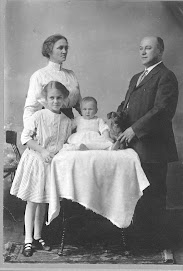In the 19th century shtetls were mainly found in the areas which were known as the Pale of Settlement in the Russian Empire, the Congress Kingdom of Poland, Galicia and Romania. Since our family knows that Joseph stated Tauroggen as his birthplace in his naturalization papers, this placed his family in this area.
Further searching uncovered a description of life in the shtetl as noted in Chapter 15 of There Once was a World: a Nine-Hundred-Year Chronicle of the Shtetl of Eishyshok by Yaffa Eliach. Although I can't be sure if the descriptions paralleled Joseph's life, there were certain aspects that may have impacted both his childhood and the remainder of his life. Specifically:
- The Household: Often three generations lived under the same roof. The pattern in Eastern Europe dating from at least the seventeenth century, was for young couples to establish their first household in the home of the wife's family. This made me wonder about the mention of Tilsit in connection with Joseph. At one point it was thought that was his birthplace but this was corrected by finding his naturalization certificate and his US Army enlistment. Now I wonder if perhaps that could be where his father was from and he came to Tauroggen where his wife's (Joseph's mother) family lived. If you have any information that would shed light on this, please feel free to share.
In addition, Joseph's mother passed away when he was a baby and his father remarried. This meant he may have been part of another household. - Sons-In-Law: The treatment a son-in-law received in his new household may have differed greatly from what he experienced in his home prior to his marriage. In the matriarchal society of homes, a son-in-law was often thought to be doing wrong much of the time unless he he was an aspiring scholar.
- The Jewish Matriarch: In Eastern Europe of the seventeenth, eighteen, and nineteenth centuries, the home and its modest commercial enterprises were the woman's domain. This makes it important to discover more about Joseph's mother and stepmother. Could one of them have been the owner of the hotel/inn mentioned in Marrom family stories?
- Step-Siblings and Orphan Relatives: During the eighteenth and nineteenth centuries and the first two decades of the twentieth, perhaps as many as two-thirds of the marriages in the shtetl were second, third, and even fourth marriages. This was the result of death rather than divorce. Death also created a large number of orphans. Many spouses brought with them the children from previous marriages where they were often considered a heavy burden and resented. Could this have contributed to Joseph's immigration to the United States at such a young age? Another factor may have been the anti-Semitic practice in Russia of impressing Jewish teenage boys into mandatory military service for as long as a 25 years.
 |
| Painting of Anatevka: Everything I knew, or thought I knew, of Jewish life in Russia prior to the Russian Revolution came from the movie, Fiddler on the Roof |
Stetl: Taurage (Alternative Names/Spellings - Taurage/Lithuanian,
Tovrik/Yiddish, Tauroggen/German, Taurogi/Polish,
Taurage/Latvian,
Taurogen, Tarogen, Tauragunay, Tauragnu, Tauragnay,
Tauraginos, Tauraginai
District (Uyezd): Zarasai (I also found a reference to Raseiniai)
Province (Guberniya): Kaunas
 |
| Random boy in Lithuanian shtetl posted on Webshots.com by itzko102 |



